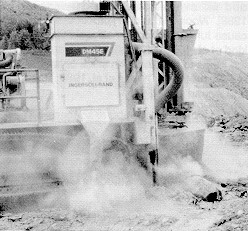 MSHA published a final rule on dust control for surface highwall drills on April 19, 1994. The rule is designed to protect miners, working on and around surface highwall drills, from exposure to harmful amounts of dust containing crystalline silica. Breathing excessive amounts of crystalline silica during rock drilling, can cause a serious fatal respiratory disease called “silicosis”, according to the National Institute for Occupational Safety and Health (NIOSH).
MSHA published a final rule on dust control for surface highwall drills on April 19, 1994. The rule is designed to protect miners, working on and around surface highwall drills, from exposure to harmful amounts of dust containing crystalline silica. Breathing excessive amounts of crystalline silica during rock drilling, can cause a serious fatal respiratory disease called “silicosis”, according to the National Institute for Occupational Safety and Health (NIOSH).
What is silica (quartz)?
The terms “crystalline silica” and “quartz” refer to the same thing. Quartz is a natural constituent of the earth’s crust and is not chemically combined with any other substance.
What is silicosis?
Silicosis is a disease of the lungs due to breathing of dust containing silica particles. Silica dust can cause fibrous or scar tissue formations in the lungs which reduce the lung’s ability to work to extract oxygen from the air. There is no cure for this disease, thus, prevention is the only answer.
What are the symptoms of silicosis?
There are several stages of silicosis. Early stages may go completely unnoticed. Continued exposure may result in the exposed person noticing a shortness of breath upon exercising, possible fever and occasionally bluish skin at the ear lobes or lips. Silicosis makes a person more susceptible to infectious diseases of the lungs. Progression of the disease leads to fatigue, extreme shortness of breath, loss of appetite, pain in the chest cavity which all may lead eventually to death. Acute silicosis may develop after short periods of exposure. Chronic silicosis usually occurs after 10 or more years of exposure to lower levels of quartz.
Where are miners exposed to silica dust?
The most common exposures occur during the drilling of rock, crushing, and loading of mine material. Miners operating equipment such as highwall drills, end loaders, dozers and trucks on mine property have a high probability of exposure. Furthermore, all miners working at surface coal mines are at risk of being exposed to silica-containing dust.
How is MSHA addressing exposure to silica dust?
MSHA has published a rule which requires that controls be used when drilling rock to prevent miners from being exposed to dust from the drilling action. This regulation requires that holes be drilled wet or that other effective means be used to prevent dust exposures. Use of dry dust collectors on drills is an example of an effective means of control. MSHA continues to enforce the 2.0 mg/m3 or lower standard for respirable coal mine dust. Samples are analyzed for silica content to determine if the respirable dust standard should be reduced to control the miner’s exposure to silica.
What can miners do to limit their exposure to silica containing dust?
Mine operators are required to provide and assure the use of appropriate controls for dust while drilling in rock. Miners should be sure to use all available engineering controls such as dust collectors, wet drilling, drill platform skirts and enclosed cabs. Miners should adjust their work procedures so that they do not stand in dust clouds. While not accepted as a primary control, miners should make use of respirators made available by the mine operator, to provide the maximum protection possible, especially when necessary to work in dust for short periods. If a respirator is used, the miner and mine operator should assure that it is approved for use in silica-containing dust, that it is maintained as approved, worn as designed (not altered in any way), equipped with new filters at least each shift, and fitted so as to provide a tight seal to the face. Miners wearing a respirator can not have beards/mustaches which interfere with the respirator seal to the face.
How can a person determine if he/she has silicosis?
Miners must undergo a medical examination to determine the presence of silicosis. An examination is encouraged for miners who have worked in areas with a high probability of exposure to silica-containing dust. The medical examination should include: a medical and work history, detailing exposure to silica dust, observation of early signs and symptoms of respiratory disease, chest x-ray, pulmonary function test (spirometry) – commonly called a breathing test, and evaluation for tuberculosis.
Mine operators are required to report to MSHA any cases of silicosis or other occupational lung disease for which a medical diagnosis or a notice of an award of compensation is received involving a miner.
If you have any questions about any occupational health matter, feel free to ask us. Our job is to protect your health.
Contact
Mine Safety and Health Administration
Coal Mine Safety and Health Division
1100 Wilson Boulevard
Arlington, Virginia 22209-3939
Phone:(202) 693-9630
Source: Mine Safety & Health Administration
Discussion
No comments yet.